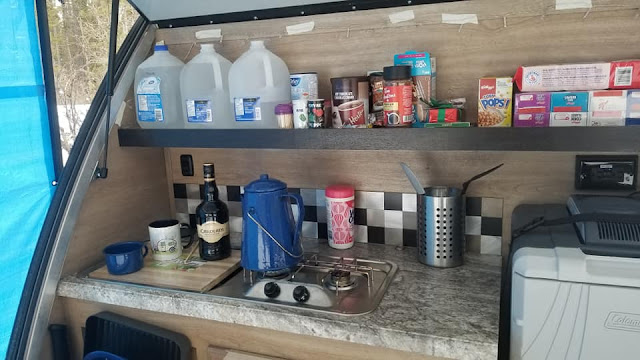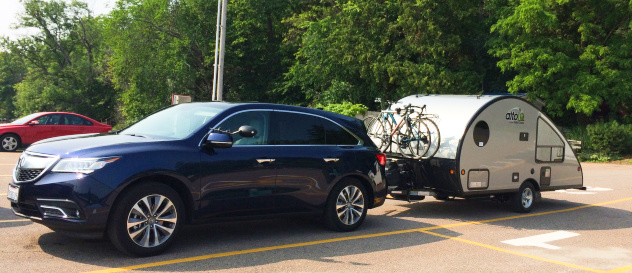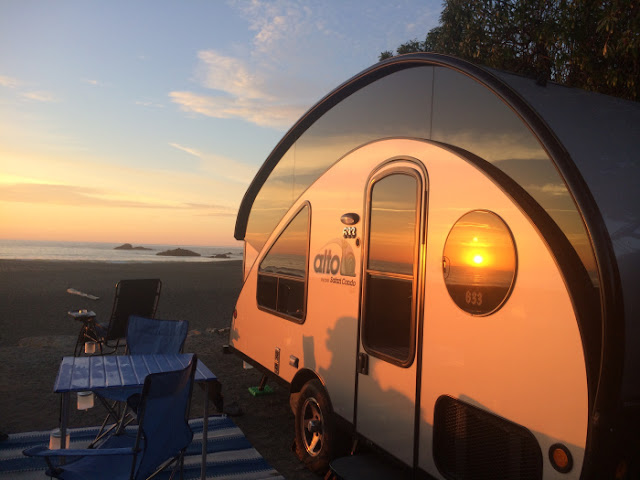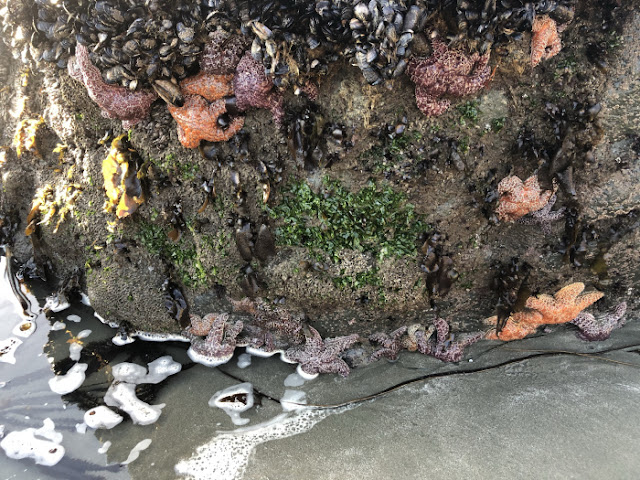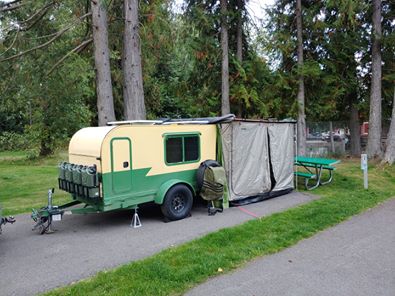 |
| My dad and mom and their 1944 honeymoon rig |
What does it mean to camp with a tiny trailer, the classic model being a 4 x 8 foot teardrop? Mostly, it means that you're willing to do without, that you believe "less is more." Built-in toilet and bath? Nope. Built-in inside kitchen? Nope. Heating and air conditioning? Probably not in the smallest and most basic. You're beginning to get the idea as to why the most basic tiny trailers are sometimes endearingly called "a bed on wheels." And owning a bed on wheels, many would say, is the best RV to get you outside as much as possible yet still provide you with a comfy, secure place when the sun is going down.
Gearing Up
John Muir would appreciate that minimalist approach to camping, even if driving a car and pulling a bed on wheels were not possible in his time. Even in his times, though, Muir was a minimalist.
In 1867, at the age of twenty-nine, John Muir set off on a hike of one thousand miles across the southern United States, just after the Civil War. When he set off from his family home in Indiana on his hike to the Gulf of Mexico, he later wrote, "I rolled up some bread and tea in a pair of blankets with some sugar and a tin cup and set off." As a naturalist he did take some scientific equipment with him, but he still was traveling light, camping out and also staying in the homes of both newly-freed slaves and plantation owners ("
A Thousand Mile Hike to the Gulf"). Six years later, he was in California and setting out to explore the Hetch-Hetchy Valley in the Sierra Nevadas, and I describe his preparations in my article, "
John Muir Goes A-Campin' at Hetch Hetchy":
"Muir decides to visit Hetch Hetchy during the first week of November, so there is some danger of snow. This, of course, is before satellite weather forecasting, so in his usual inimitable manner, Muir takes three loaves of bread for his food--one for the trip up, one for the trip back, and one for emergencies. He also has his blanket and a nice cup for his "complementary coffee"--Muir, the glamper! "Thus grandly allowanced, I was ready to enjoy my ten days' journey of any kind of calm or storm."
I think Muir would appreciate, even if it isn't backpacking, a camping lifestyle in which discrimination decides what to not pack, rather than how much one can pack and still roll. A tiny trailer owner thinks in terms of what is essential and non-essential, what to pack that has multiple uses, and, for many, what can increase the connection with nature. Tiny trailer camping isn't as extreme as backpacking or bike camping, but it can provide a great basecamp for those pursuits. Furthermore, tiny trailer camping, even in its tamest forms, continually reminds us to cut the superfluous and to indulge ourselves with great vistas rather than gewgaws.
Dealing with the Elements
John Muir's less-is-more approach to camping thrust him into the elements, which he superbly described, whether it be spring sunshine or winter storm. He packed for adversity--more or less--and often met it. When hiking Hetch-Hetchy, he brought that third loaf of bread in case of storm, and needed it, for he was caught in a November snowstorm during his trek, not before finding time to build a tiny, makeshift shelter, though.
"Shortly after I had gained the summit of the divide between the main river and the middle fork, the sky, which had been growing dark and opaque all the forenoon, began to yield snowflakes. I at once hastened to a sheltered hollow which was groved with firs and watered by a tiny brook. I searched until I found a place where a number of large trees had fallen, which in case the storm should be severe would afford abundance of fire. At the stump of one of these trees, which had splintered in falling, I found plenty of laths from two to ten feet long, with which I could make a hut, but I had not sufficient time, as the snow began to fall fast. Beneath one of my fire logs I hastily burrowed a sort of bear’s nest, and lined it with branchlets of fir - that was home. Then I gathered up a large pile of dry limbs in my front yard, and made a fire before the door, and boiled a cup of coffee, and went into the house. The storm was earnest, and I most intensely enjoyed its growing magnificence."
 |
| The Hetch-Hetchy Valley, California, 1870s, oil on canvas by German-American artist Albert Bierstadt (1830-1902), currently at the Wadsworth Atheneum Museum of Art, Hartford, CT. (Image courtesy of Wikimedia Commons) |
Spending the night admiring the beauty of the song of snowy wind among the 200-foot firs that surround him, the storm blew itself out during the night, depositing only a few inches of snow. With the stars came colder weather, and he was up during the night, adding wood to his fire.
Like Muir, tiny campers have to adapt themselves to the elements, learning to enjoy the cold twinkle of stars at night when they leave their trailers for a quick "call of nature." Tiny campers bundle up and cook outside and find that adapting to the cold is easier than expected. As the weather grows more intense, tiny campers look for the "growing magnificence" of the moment, as did Muir. I consider such moments opportunities to learn and experiment, to try new things, as I related in my article "
Cold Weather Cooking in a Tall Teardrop." A little snow and some weather in the teens, and I had the chance to learn and grow. "The extremes of weather are providing learning opportunities for us, though. My last camping trip involved a couple of days of wind, temperatures in the teens, and blowing snow, which provided a perfect chance to try cooking indoors. I found that cooking in my tiny trailer is manageable, even though not as much fun as cooking outside, where I have more elbow room." Cooking outside doesn't have to all be about survival, though. I've written about tiny trailer campers who enjoy cooking outside with cast iron.
Sometimes, though, the camping experience, especially with tiny trailers, can be an experience of extremes, or at least what we modern folks call extremes. The little havens of our trailers, though, do provide havens for us to get to some degree out of the wind, rain, snow, bugs, and heat. Tiny trailers extend our range of comfort and, therefore, extend the number of days we can be camping.
Muir's camp skills helped him experience comfort while camping, but his camping style also required those skills, to be quite honest, to keep him alive, as seen in his essay "
Snow-Storm on Mt. Shasta." He and a colleague were engaged in meteorological data collection on California's Mt. Shasta. The article is an interesting blend of scientific observation and exciting description of the adventure. Not having a tiny trailer to hole up in when a snowstorm hit at the end of April in 1875, Muir had to deal with the elements in order to survive. He and his colleague Jerome had an intense discussion as to whether to make their way down the treacherous, icy slopes of the volcano or to hunker down, inadequately prepared for the storm--Muir was in shirt-sleeves. Muir's companion finally opted for an area of hot springs as refuge, and Muir followed.
"Our discussions ended, Jerome made a dash from behind the lava block, and began forcing his way back some twenty or thirty yards to the Hot Springs against the wind flood, wavering and struggling as if caught in a torrent of water; and after watching in vain for any flaw in the storm that might be urged as a new argument for attempting the descent, I was compelled to follow. "Here," said Jerome, as we stood shivering in the midst of the hissing, sputtering fumaroles, "we shall be safe from frost." "Yes," said I, "we can lie in this mud and gravel, hot at least on one side; but how shall we protect our lungs from the acid gases? and how, after our clothing is saturated with melting snow, shall we be able to reach camp without freezing, even after the storm is over? We shall have to await the sunshine; and when will it come?"
Muir was indeed a trailblazer, and I have to admit that I follow his path much more cautiously, safely, and comfortably.
How We Roll
When I bought my tiny trailer, the Green Goddess, I had never before towed a trailer of any kind. In fact, my vehicle hadn't even had a hitch when I bought my "standy" teardrop. My son-in-law drove me the two-plus hours to Des Moines, hitched up the trailer, and we came back home, me a spectator the whole trip. I got my vehicle fixed up, though, and practiced and learned the basics. I know my limitations, though, even if I am much better at towing now, after two seasons of camping. I'm much more confident but still am cautious. My closest call of being in a tight spot was when I traveled to
Backbone State Park in NE Iowa. Following GPS directions, I approached the park, only to find the the secondary entrance was gated and locked shut. The narrow road had a deep ditch on each side. Luckily, at the gate even with a couple of cars parked, there was still room for my tiny trailer to flip a U-turn; otherwise, I would have had a very long experience of practicing backing up.
On another trip, this one in South Carolina, I was (again) following GPS directions for entering
Huntington Beach State Park. Directions turned me left into a narrow-streeted residential area. I learned later that the park had changed its entrances. I knew I just had to turn around and head back the direction I had come from. The road was divided, and I could catch the new entrance by heading back to the main highway. Where to turn around, even with my tiny trailer? Traffic was not heavy, though, and I found a crossroads and a home with a triple-wide driveway (to match the 3-car garage), and there managed to turn around without damaging my tow rig or residential property . . . or excessively bruising my pride.
Although he traveled by shank's mare, Muir still had to often think through the safest path. During his Hetch-Hetchy tramp, Muir decided on trying a shortcut, following a grizzly's path, thinking that since there were no return tracks, the bear had found a way through the cliffs. After all, he thought, he could go anywhere a bear could.
"This made me more hopeful than before of being able to creep along the wall to the main traveled road, but the track appeared fresh, and the possibility of meeting long claws upon so conquer-or-die a place made me uneasy. I moved forward with great caution until I came to a recess where a few trees were anchored. Here I found that my pioneer had climbed to a sloping place on the wall above, by a dead pine that leaned against it like a ladder. Had I been empty handed like him I would have followed by the same way, but my blankets encumbered my limbs and kept them out of balance. A little farther on I was positively halted by a sheer wall, and my hour’s scramble in this direction, so far as getting to the bottom was concerned, was worse than useless."
Muir also found that traveling had its challenges on his second Alaskan glacier adventure, taking this trip with a canine companion in 1880. In "
Stickeen: the Story of a Dog," he described the challenge of a wide crevasse which blocked his and Stickeen's progress on Brady Glacier. He finally found a sliver of an ice bridge down below surface level that crossed the crevasse, and believe me, I would rather back my tiny trailer up a narrow road any day than negotiate that ice bridge!
"After the end of the bridge was reached I chipped it down until I had made a level platform six or eight inches wide, and it was a trying thing to poise on this little slippery platform while bending over to get safely astride of the sliver. Crossing was then comparatively easy by chipping off the sharp edge with short, careful strokes, and hitching forward an inch or two at a time, keeping my balance with my knees pressed against the sides. The tremendous abyss on either hand I studiously ignored. To me the edge of that blue sliver was then all the world. But the most trying part of the adventure, after working my way across inch by inch and chipping another small platform, was to rise from the safe position astride and to cut a step-ladder in the nearly vertical face of the wall,--chipping, climbing, holding on with feet and fingers in mere notches."
This was the easy part, believe it or not. Then Muir had to bring the dog down to the bridge, cross the bridge, and then encourage the dog to follow! Anybody with pets reading this will realize by now that two- or four-footed, if you were a traveling companion of John Muir, you had to be fearless. "Strange so small an animal should be capable of such big, wise fears. I called again and again in a reassuring tone to come on and fear nothing; that he could come if he would only try. He would hush for a moment, look down again at the bridge, and shout his unshakable conviction that he could never, never come that way; then lie back in despair, as if howling, 'O-o-oh! what a place! No-o-o, I can never go-o-o down there!'" Muir was asking no more or less of his canine companion than he would have asked of a human companion. To assuage your fears, Muir does vividly describe Stickeen working up his courage and then rushing across. I'm reminded of that travelogue TV show about the most dangerous roads in the world to drive.
Communion with Nature
To Muir's credit, the reason he traveled and camped in nature was spiritual. The wilderness was his cathedral, his place of worship. Tiny trailer campers do spend more time outside. We do interact with the elements, pleasant and challenging, more than the RVs that inhabit pull-throughs like dry-docked
Titanics. Muir's prose is filled with moments of rapture, moments of remembrance when at some vista, surrounded by nature's beauty and power, he experienced the divine beauty of the world.
In his book
My First Summer in the Sierra, Muir followed a steam until he found a spot of especial solitude and beauty.
"When I climbed on top of it to-day and lay down to rest, it seemed the most romantic spot I had yet found, -- the one big stone with its mossy level top and smooth sides standing square and firm and solitary, like an altar, the fall in front of it bathing it lightly with the finest of the spray, just enough to keep its moss cover fresh; the clear green pool beneath, with its foam-bells and its half circle of lilies leaning forward like a band of admirers, and flowering dogwood and alder trees leaning over all in sun-sifted arches.
How soothingly, restfully cool it is beneath that leafy, translucent ceiling, and how delightful the water music--the deep bass tones of the fall, the clashing, ringing spray, and infinite variety of small low tones of the current gliding past the side of the boulder-island, and glinting against a thousand smaller stones down the ferny channel! All this shut in; every one of these influences acting at short range as if in a quiet room. The place seemed holy, where one might hope to see God."
Muir managed with words to accomplish what most of us hope to achieve with our phone-cameras: to capture to some degree the greater dignity and grandeur that we intuitively recognize as being kin to some inner green valley within ourselves. He reminds us that what is inside us and outside is connected by the common link of our consciousness. I believe that John Muir would applaud the lighter footprint of tiny trailer camping, and the conscious decision on tiny trailer owners to adopt a camping lifestyle that emphasizes more time outdoors. Considering how easy it is to spend time indoors in our modern era, choosing sun and moon, snow and heat, a clean breeze and a blue sky--Muir would readily agree with the reasons why so many campers are choosing to camp in tiny trailers.
I summarized the motivations of tiny trailer camping in my article "
Why Such a Tiny Trailer? Teardrop Owners Speak Out." I think Muir articulates it best in his (for me) humorous essay titled "
Wild Wool," where he logically goes on and on about how the wool of wild sheep is better than that of domestic sheep--and I mean
on and on! He finally arrives at his main abstract concept of the essay, that Nature does not exist solely for the convenience of human beings. Rather, humans are a part of nature and that all of existence has significance and value. He celebrates the qualities of the individual as essential components of the whole. "I have never yet happened upon a trace of evidence that seemed to show that any one animal was ever made for another as much as it was made for itself." Muir discovered in Nature that he was most himself when he was a part of the greater whole. May we find such epiphanies in campfire and woodsmoke, in owl song and moonlight, as did Muir. The greater realities exist, if we will only look, listen, and learn.






